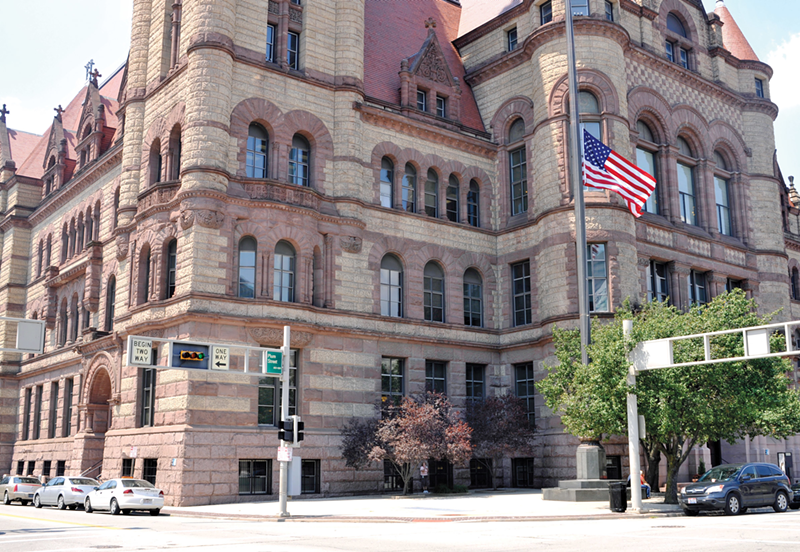If Cincinnati does not lease its parking assets to the Port of Greater Cincinnati Development Authority, it will have to pay off a $35 million deficit in the fiscal year 2014 budget through other means, but those means were disputed at a special session of City Council today.
City Manager Milton Dohoney Jr. and other city administration officials say the city will have to carry out Plan B, which would lay off 344 city employees, including 189 cops and 80 firefighters. But council members Chris Seelbach, P.G. Sittenfeld, Charlie Winburn and Chris Smitherman claim there are other ways — casino revenue and cuts elsewhere — to balance the budget.
The meeting got testy after a few council members called the city administration “disingenuous” for framing Plan B and the parking plan as the only two budget options, prompting Mayor Mark Mallory to slam council members for attempting to pin the city’s budget woes on the city administration.
“I don’t think anyone in the administration wants to see their colleagues laid off,” Mallory said. “The administration makes a recommendation to this mayor and to this council. The final decision makers are the elected leaders.”
He added, “What’s disingenuous is to create a crisis and then criticize the administration for its response to the crisis when those responsible for dealing with the crisis are the elected leaders. It would be like an arsonist setting a building on fire and then complaining about how long it took the fire department to get there and what equipment they used to put out the fire.”
Lea Eriksen, the city’s budget director, said the ideas she heard at the special session today would not be enough to close the budget gap.
Throughout the discussion, the city administration repeatedly dismissed ideas presented by council members as not enough to overcome the city’s $35 million deficit and avoid layoffs. By the city administration’s admission, even Plan B would only close about $26 million of the projected deficit.
How that budget gap is closed may come with additional expenses. Eriksen said the budget gap may reach $45 million if the city carries out Plan B because the city would also be forced to pay for accrued leave and unemployment insurance.
Still, Assistant City Manager David Holmes admitted the city could balance the deficit without Plan B or the parking plan, but the numbers must “add up” and would require direction from City Council.
When the discussion came to casino revenues, Holmes said the city administration feels “uncomfortable” projecting casino revenue because the state’s projections have trended downward in the past few years. In 2009, the state government estimated Ohio’s casinos would take in $1.9 billion a year, but that projection was changed to $957.7 million a year in February.
Eriksen said the city estimates between $9 million and $11 million in casino funds will be available to the city. She said even if Cincinnati’s Horseshoe Casino hits its $100 million goal, the city will not be able to get the $21 million previously touted by Horseshoe Casino General Manager Kevin Kline because the money is pooled with money from other casinos around the state, which has fallen far below projections, before it’s distributed to cities and counties.
When asked about shifting parking meter revenue to the general fund to help balance the budget, Eriksen said doing so would ultimately be a “wash” because of expenses currently attached to parking meter revenue.
Seelbach suggested making more cuts through the priority-driven budgeting process. Eriksen explained Plan B does cut programs that were poorly ranked by the process — the mounted patrol unit, arts funding and recreation centers were a few examples she cited. But only relying on programs ranked poorly by the priority-driven budgeting process would “decimate” departments and programs that the city deems essential, she said.
In the original 2013 budget proposal put forward by the city manager, mounted patrol was cut, but Seelbach lobbied for the program’s restoration.
Multiple council members brought up traveling and training costs as potential areas to cut, but Eriksen said the city administration had not considered further cuts in those areas because the leftover expenses are currently used to get certifications that city employees “need to do their jobs.”
Councilman Charlie Winburn, the lone Republican on City Council, asked the city administration if they tried to balance the budget without layoffs. Eriksen replied, “Yeah, that was called the parking plan.” She added without the parking plan, it would be “mathematically impossible” to balance the budget without layoffs.
When Winburn suggested city employees should take salary cuts, Eriksen said such cuts would require extensive negotiations with unions because about 90 percent of the city’s employees are unionized.
In November, Winburn was one of the prominent supporters of giving the city manager a raise and bonus.
Vice Mayor Roxanne Qualls, a Democrat running for mayor, said she would be open to using any revenues possible for reducing the budget gap, but she said City Council must acknowledge the harsh budget realities facing the city — further re-emphasizing points she made in
a blog post Sunday
.John Cranley, another Democrat running for mayor, has said in the past that the threat of layoffs is “the boy crying wolf.” Cranley
released his own budget plan
on March 28 that he says would avoid layoffs and balance the budget without the parking plan, but some critics say the budget’s revenue estimates are unrealistic.Eriksen said Cincinnati has run structurally imbalanced budgets since 2001, but city officials say deficits have been made much worse by state cuts in local government funding carried out by Gov. John Kasich and the Republican legislature since 2010 (
“
Enemy of the State ,”
issue of March 20).City Council approved the parking plan in a 5-4 vote on March 6 that would lease the city’s parking assets to the Port Authority to raise funds that would help balance the deficit for the next two fiscal years and pay for new development projects, including the construction of a downtown grocery store (
“Parking Stimulus,”
issue of Feb. 27).Opponents of the parking plan, who say they fear it will lead to rate hikes, filed their petitions for a referendum effort today. It is so far unclear whether they have the 8,522 verified signatures required to put the issue on the November ballot.






